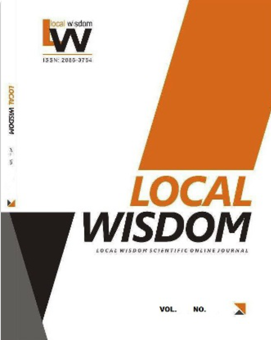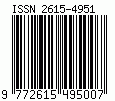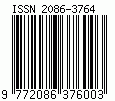Traditionally Catching and Processing of Laor in Moluccas Islands
DOI:
https://doi.org/10.26905/lw.v12i2.4078Keywords:
Bakasang, Laor, Lawar, Tanggo, Timba laorAbstract
Laor is a fishery product that found in Moluccas at March or April, a few days after the full moon. The swarming of laor in Moluccas is called timba laor. This event is one of the local wisdoms that must be conserved. The people have always consumed this worms for long time, but research of catching and processing techniques of laor has never been done. This research aimed to describe the techniques of catching and processing laor in Moluccas Province. This research was descriptive qualitative. Data was collected from direct observations and documentation from volunteers in several villages only in Moluccas Province, i.e. Latuhalat (Ambon), Booi (Saparua), Taruy (Geser), Elaar (Kei), and Emplawas (Tepa) villages. The catching and processing laor were very diverse in Moluccas. The people were usually catch of laor used a tanggo, both of triangular or oval shape. Laor that has been taken then processed into laor lawar and bakasang. Both of these food products were very popular in Moluccas community. This research was expected to conserve of timba laor culture to support the tourism in Moluccas province.
Downloads
References
Bachtiar, I. and Bachtiar, N.T. (2019). “Predicting spawning date of nyale worm (Eunicidae, Polychaeta) in the Southern coast of Lombok Islands, Indonesiaâ€, Biodiversitas, 20(4), 971-977.
Burrow, W. (1955). “Palolo, notes on the periodic appearance of the annelid worm Eunice viridis (Gray) in Southwest Pacific Islandsâ€, The Journal of Polynesian Society, 64(1), 137-154.
Colin, A. (1896). Bemerkungen uber den essbaren palolowurm, Lysidice viridis Gray. The Indian Press, Kolkata.
Geurtjens, H. (1913). “Kei eilanden, uit Oewat schrijftâ€, de Java Post, 14, 217-219
Horst, R. (1904). “Wawo and palolo wormsâ€, Nature, 69, 582.
Jansen, H.J. (1939). “Ethnographische bijzonderheden van enkele Ambonsche negorijenâ€, Bijdragen tot de Taal-Land and Volkenkunde, 98(1), 325-368.
Koesoemawardani, D., Hidayanti, S., et al. (2018). “Amino acid and fatty acid compositions of rusip from fermented anchovy fish (Stolephorus sp)â€. Materials Science and Engineering, 344, 1-6.
Latumahina, M..CA. (2011). “Pengolahan dan komposisi gizi cacing polychaeta di Pulau Ambonâ€, In: Jambormias E, Riupassa, PA (eds). Prosiding Seminar Nasional Pengembangan Pulau-pulau Kecil dari Aspek Perikanan Kelautan dan Pertanian. Institut Pertanian Bogor, Bogor, 247-253.
Liline, S., Amin, A., et al. (2016). The Identification of laor worm (polychaeta) in marine areas of Ambon Island, Moluccas Province, Indonesia based on 16S rRNA gene sequence, International Journal of Chemical and Technology Research, 9(66), 307-315.
Ludeking, E.W.A. (1868). De Schets van Residentie Amboina. S. Gravenhage, Amsterdam.
Mahulette, F. and Kurnia, T.S. (2020). “Microbiological quality and proximate composition of bakasang laor, a traditional fermented fishery product in Malukuâ€, Biosaintifika, 12 (1).
Mahulette, F. and Leimena, H.E.P. (2012). Komposisi spesies, kepadatan biomassa, dan kondisi habitat cacing laor (Polychaeta) di perairan Pulau Ambon (Laporan Penelitian), Pustaka Karya Ilmiah Ristek, Jakarta.
Mahulette, F. (2020). “The swarming and benefits of laor in Moluccasâ€. In: Sekiguchi Global Research Association (Eds). Suistainable Shared Growth: Proceeding of The 5th Asia Future Conference. Sekiguchi Global Research Association, Manila, 710-715.
Martens, J.M., Heuer, U., et al. (1995). “Swarming of palola viridis Gray and other Polychaeta such as Lysidice oele Horst and Lumbrineris natans sp nov on Ambonâ€. Mitteilungen Aus Dem Hamburgischen Zoologischen Musium Und Institut, 92, 7-33.
Mataxas, A. and Scheibling, R.E. (2016). “Rapid eeg transport following coral mass spawning at Ningaloo Reef, Western Australia, Bulletin of Marine Science, 92(4), 529-544.
Monk, K. A., de Fretes, Y., et al. (1997). The Ecology of Nusa Tenggara and Maluku. Periplus Edition, Singapore.
Nagja, T., Vimal, K., et al. (2015). “Myristica fragrans: a comprehensive reviewâ€. International Journal of Pharmacy Sciences, 8(2), 27-30.
Pical,V.J. (2013). “Kinerja aparat pengelola sumberdaya perikanan berbasis masyarakat di Kota Ambonâ€, Jurnal Triton, 9(1), 33-41.
Radjawane, T.R. (1987). Laor, Cacing Laut Khas Perairan Maluku. Lomba Karya Ilmu Pengetahuan bagi Remaja 1982, Balai Pustaka, Jakarta.
Rumphius, G.E. (1999). The Ambonese Curiosity Cabinet. Yale University Press, London
Sukenti, K., Hakim, L., et al. (2016). “Ethnozoological study on Sasak cuisines: diversity, utilization, social, cultural, and nutritional aspectsâ€, Pakistan Journal of Life and Social Sciences, 14(3), 171-177.
Tadataka, I. (2018). “Palolo swarming, celestial cycles, and indigenous calendrical systems in Indonesiaâ€, æ±å—ã‚¢ã‚¸ã‚¢ç ”ç©¶, 55(2), 111-138.
van der Burg, C. L. (1904). De Voeding in Nederlandsch-Indië, J.H. de Bussy, Amsterdam.
van Ekris, A. (1864). “Woordenlijst van eenige dialecten der landtaal op de Ambonsche eilandenâ€,Mededeelingen van wege het Nederlandsche Zendelinggenootschap, 8, 1-472.
van Hoevell, G.W.W.C.B. (1877). “Iets over de vijf voornaamste dialecten der Ambonsche landtaal,†(bahasa tanah). Bijdragen tot de Taal-, Land- en Volkenkunde van Nederlandsch-Indië, 25(1), 1–136.
Villee, C.A, Walker, W.A., et al. (1969). General Zoology, Third Edition. Topan Company, Japan.
Weber, M. (1902). Siboga Expeditie, Introduction et Description de L’ Expedition. E.J. Brill. Leiden.
Welsem, J.W.A. (1915). Herinneringen uit de Molluken, De Tropische Natuur, Amsterdam.
Woodworth, W. McM. (1907). The palolo Worm, Eunice viridis (Gray). Museum of Comparative Zoology, Massachusetts.












